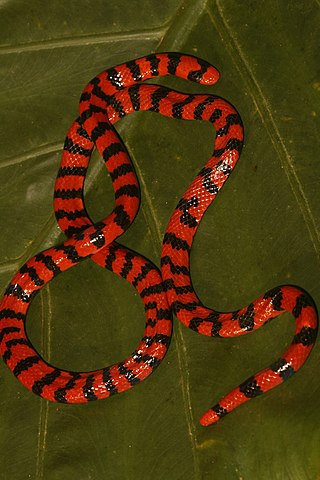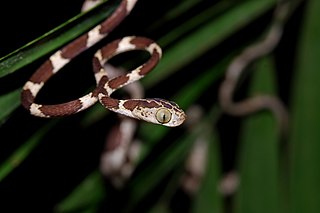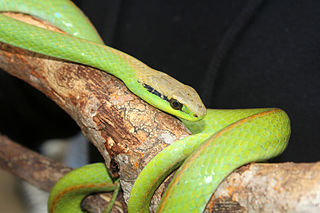
The milk snake or milksnake, is a species of kingsnake; 24 subspecies are currently recognized. Lampropeltis elapsoides, the scarlet kingsnake, was formerly classified as a 25th subspecies, but is now recognized as a distinct species. The subspecies have strikingly different appearances, and many of them have their own common names. Some authorities suggest that this species could be split into several separate species. They are not venomous to humans.

The scarlet kingsnake or scarlet milk snake is a species of kingsnake found in the southeastern and eastern portions of the United States. Like all kingsnakes, they are nonvenomous. They are found in pine flatwoods, hydric hammocks, pine savannas, mesic pine-oak forests, prairies, cultivated fields, and a variety of suburban habitats; not unusually, people find scarlet kingsnakes in their swimming pools, especially during the spring. Until recently, and for much of the 20th century, scarlet kingsnakes were considered a subspecies of the milk snake; however, Pyron and Bubrink demonstrated the phylogenetic distinction of this species and its closer relationship to the mountain kingsnakes of the southwestern United States. These largely fossorial snakes are the smallest of all the species within the genus Lampropeltis, usually ranging from 40 to 50 cm at maturity. The maximum recorded length is in Jonesboro, AR 76.2 cm (30.0 in). Hatchlings range in size from 8 to 18 cm .

Coral snakes are a large group of elapid snakes that can be divided into two distinct groups, the Old World coral snakes and New World coral snakes. There are 27 species of Old World coral snakes, in three genera, and 83 recognized species of New World coral snakes, in two genera. Genetic studies have found that the most basal lineages have origins in Asia, suggesting that the group originated in the Old World. While new world species of both genera are venomous, their bites are seldom lethal; only two confirmed fatalities have been documented in the past 100 years from the genus Micrurus. Meanwhile, snakes of the genus Micruroides have never caused a medically significant bite.

The Aniliidae are a monotypic family created for the monotypic genus Anilius that contains the single species Anilius scytale. Common names include the American pipe snake and false coral snake. It is found in South America. This snake possesses a vestigial pelvic girdle that is visible as a pair of cloacal spurs. It is ovoviviparous. It is non-venomous, and its diet consists mainly of amphibians and other reptiles. Two subspecies are recognized, including the nominate subspecies described here.

Imantodes cenchoa, also known commonly as the blunthead tree snake, the neotropical blunt-headed tree snake, and the fiddle-string snake, is a species of mildly venomous, rear-fanged snake in the family Colubridae. The species is native to Mexico, Central America, and South America.

Oxyrhopus petolarius, commonly known as the forest flame snake, is a species of mildly venomous snake in the family Colubridae. The species is endemic to Central and South America. There are three recognized subspecies.

Erythrolamprus aesculapii, also known commonly as the Aesculapian false coral snake, the South American false coral snake, and in Portuguese as bacorá, or falsa-coral, is a species of mildly venomous snake in the family Colubridae. The species is endemic to South America.
False coral may refer to many species of snakes, including:

Oligodon is genus of colubrid snakes that was first described by Austrian zoologist Leopold Fitzinger in 1826. This genus is widespread throughout central and tropical Asia. The snakes of this genus are commonly known as kukri snakes.
False coral snake may refer to:
Erythrolamprus ornatus, also known commonly as the ornate ground snake and the Saint Lucia racer, is a species of snake in the family Colubridae. The species is native to the eastern Caribbean. It is the rarest snake on earth with fewer than 20 left in the wild.

The military ground snake is a species of snake in the family Colubridae. The species is endemic to South America.

Oxyrhopus, the false coral snakes, is a genus of colubrid snakes that belong to the subfamily Dipsadinae. All 15 members of the genus are found in the northern part of South America, with the native range of the most widespread member, Oxyrhopus petolarius, extending into Central America and Trinidad and Tobago as well.

Oxyrhopus melanogenys, commonly known as Tschudi's false coral snake, is a colubrid snake species found in the northern part of South America.

Philodryas olfersii is a species of venomous snake in the family Colubridae. The species is endemic to South America.
Hexametra boddaertii is a parasitic roundworm belonging to the family Ascarididae. H. boddaertii was originally described from a single specimen of Mastigodryas boddaerti, a South American colubrine snake. Other neotropical colubrids identified as hosts to H. boddaertii include Oxyrhopus trigeminus, Philodryas patagoniensis, Spilotes pullatus, Trimorphodon biscutatus, Philodryas baroni, and Oxyrhopus guibei. It is thought that Hexametra may be the causative agent of ocular disease, diffuse unilateral subacute neuroretinitis, (DSUN), in Brazil.

Clelia clelia, commonly known as the black mussurana or windward cribo, is a species of snake in the family Colubridae. The species is native to the New World.
The western keeled snake is a species of snake in the family Pseudaspididae. It is native to western Namibia, southwestern Angola, and southwestern Zambia, and is the only member of the genus Pythonodipsas.

Oxyrhopus trigeminus , the Brazilian false coral snake, is a species of snake in the family Colubridae. The species is native to Brazil, Bolivia, and Peru.














